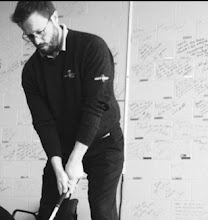Compared to the full swing there has been little written about the short game and also many golfers avoid working on this area of there game. A putt is probably looked at as the simplest shot form played in golf, but the most important shot form when lowering your score. Not every golfer has the talent or the physical capability to make repeatable putt stroke like a tour professional. As every golfer has the possibility to improve there short game and through this save a hand full of shots.
1. Putting
Green Reading
The most commonly talked about thing when reading greens is that its just down to experience and time to learn to judge the breaks and slopes on the greens. This is not entirely true there is a method and a easier way to read a putts. So here are our two wonderful tips
Find the Zero Break Line.

As seen here in the we are looking for the zero break line, this is the line that has no break also its the only line on a slope that you can putt straight upwards or downwards. The line stretches out across the hole about one meter radius from the hole, this line will help identify the position where the ball will begin to roll. Generally by every pin position on a green you can find the fall line, as the Greenkeeper should find a area on the green that has a slight consistent planer break (a flat surface that maybe on a angle) one meter radius of the hole. When you think of hole 1 at your home club there you will most probably find usually 3 to 5 allocated pin position areas on every green dependent on the size of the green. So when you have found the fall line the following points are highlighted:


-You will know in which direction the ball will break.
-You will find out where the easiest putt to play is (under the hole up hill)
Every top tour pro and there caddies will receive from the tournament officials a green plan card that competitors can note down where the Zero break lines are around all likely pin positions on all greens. As this information can become useful when playing into greens as the pros can position the ball in the best possible position around the hole. So you yourself can make a note of the pin positions and zero break lines in you course plan book!!

The spider effect
From the "spider effect" that maybe seen above. All putts on the one side of the circle break from left to right and on the other side of the hole putts naturally break from right to left. through this knowledge a clear decision can be made whether the putt is to break one way or another when a difficult putt lies near to the fall line. So by knowing how the putt falls and breaks in the last meter will give you a better understanding in how the ball enters the hole. By putting this method into practice this will fore sure help reduce putts and improve your score.



















No comments:
Post a Comment